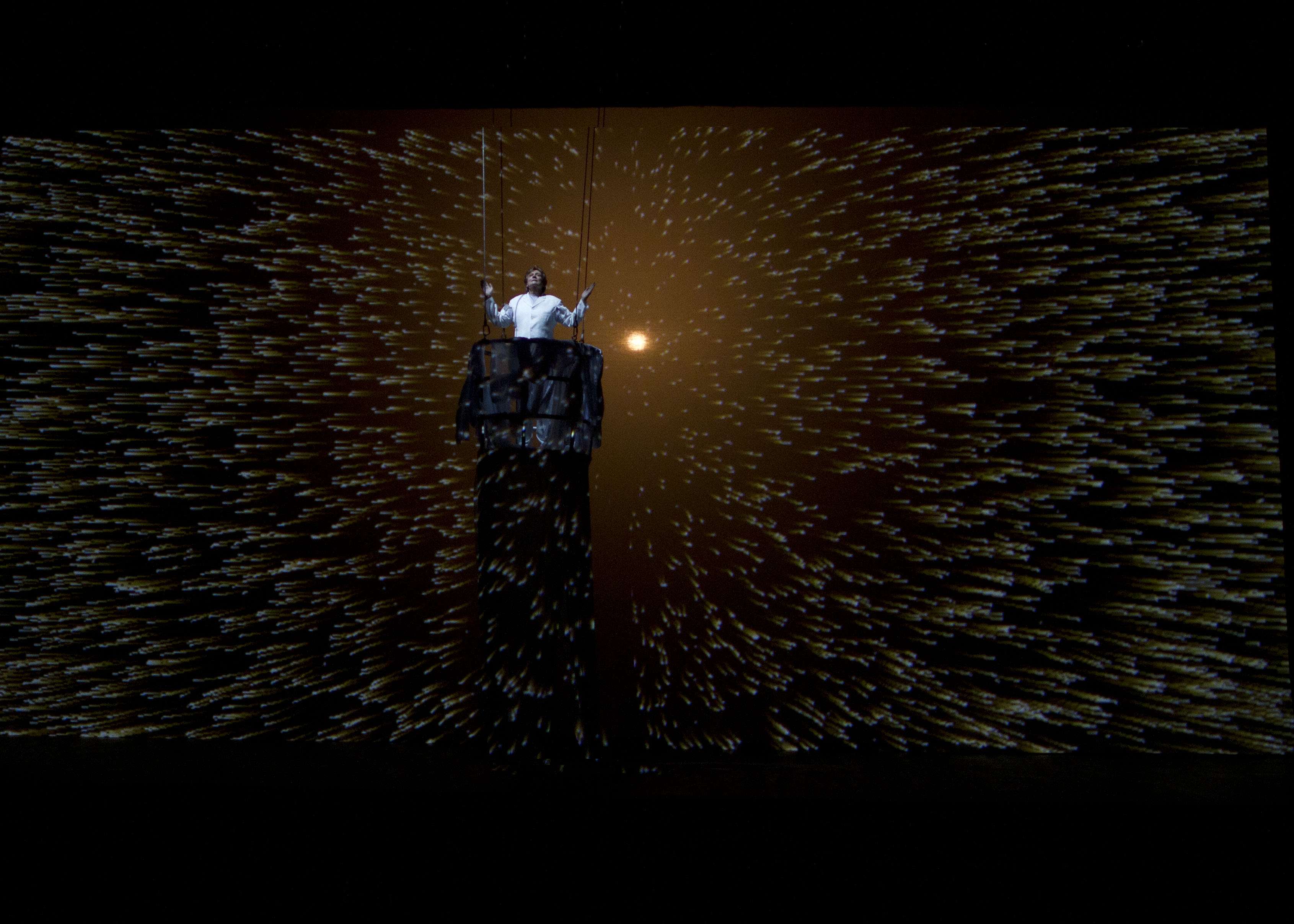|
Back
A 3-D Spectacular Los Angeles
Long Beach (Terrace Theater)
03/19/2011 - and March 27, 2011
Philip Glass: Akhnaten
Jochen Kowalski (Akhnaten), Peabody Southwell (Nefertiti), Oxana Senina (Queen Tye), Roberto Perlas Gomez (Horemhab), Ralph Cato (Aye), Tyler Thompson (Amon)
Long Beach Opera Orchestra
Benjamin Makino (Chorus Master and Assistant Conductor), Andreas Mitisek (Stage Director, Production Design and Conductor)
Frieder Weiss (Interactive Video Designer), Dan Weingarten (Lighting Designer), Nannette Brodie (Choreographer), Pete Taylor (Voice of the Scribe)

(© David Schneiderman)
As the world is glued to their television sets watching events unfold in Libya and Moammar Gadhafi’s struggle to maintain control, it also reveals the simmering unrest over the despot’s dictatorship and total disregard of his own Libyan domain. Filled with power, greed and self-absorption, it is no wonder why this Saharan country is in civil unrest. All said and done, therefore, the timing of Long Beach Opera’s opening of Akhnaten couldn’t be more apt. Last in a trilogy of “portrait” operas (the first being Einstein on the Beach followed by Satyagraha), Philip Glass’ chronicle of events surrounding Amenhotep IV demonstrates the discontent of the masses due to a ruler’s obliviousness of immediate surroundings. The rise and fall of this Egyptian pharaoh runs close parallels to today’s unfolding drama, demonstrating the stripped down version of the “haves” and the “have nots.”
Akhnaten, a three act continuum including a series of tableaux bracketed by a prologue and epilogue, is a modernized historical documentary focusing on the rise and fall of one of Egypt’s greatest pharaohs. Philip Glass, composer and librettist (along with injections by Shalom Goldman, Robert Israel and Richard Riddell) of Akhnaten, was originally described as a minimalist; however, in ensuing years, he distanced himself from the categorization in the 1970s to discover an increased development of harmonic progression and rhythmic structure. Ultimately, this distinct evolution was evidenced in his trilogy.
The high flying visuals of computer projectionist Frieder Weiss are used to accentuate actors and scenery while at the same time magnifying the already mesmerizing and intense score. Working as a parts inspector gave Weiss the initial idea of combining the quality control derivative along with his talents as a musician. This high tech approach is similar to that found in Robert Lepage’s stunning 2008 Metropolitan Opera production of Berlioz’s La Damnation de Faust (Read here) and Los Angeles Opera’s 2010 production of Franz Schreker’s Die Gezeichneten (Read here). Dan Weingarten’s lighting helps elucidate the immediate action on stage and provides an acute peripheral dimension that is most compelling.

(© David Schneiderman)
Leading the cast of singers is debuting Jochen Kowalski in the title role. Controversy over whether Akhnaten was hermaphroditic in nature due to the leader’s rather aberrant physical attributes and expressions has prompted Philip Glass to explore the possibilities of incorporating a countertenor for the role. Bearing a rare vocal commodity, Mr. Kowalski expresses his character as a somewhat vulnerable yet passionate man possessing the fervent desire of worshipping the monotheistic God, Aten, usurping his predecessors’ pantheistic beliefs. His “Hymn to the Sun”, the only text which is spoken in English, has a burnished reverence as he ascends to the sky to pay homage to his cherished deity while Long Beach Opera’s offstage chorus strikingly intercedes with powerful depth and imperious strength. This is the crowning moment of the opera.
Aside from his solo aria, Akhnaten is accompanied predominately by the strident and subservient Queen Nerftiti, sung by Peabody Southwell alongside Oxana Senina’s tenured observances as Queen Tye. As a trio, the projection is sharp and penetrating.
A sense of dramatic urgency preponderates over the music with an underlying repetitive bass droll that Glass addresses through the orchestra without the use of any violins. This trance-like motif prevails, having the same rhythmic qualities representative in John Adams’ opening of Nixon in China. Highly effective, on the surface it appears to be exact replication, but a trained ear can discern an ever so slight note modification which creates an unsuspecting transition in mood and setting.
Long Beach Opera’s chorus is a major force in Akhnaten, bearing significant dominance and angular dynamism seen through the eyes of Nannette Brodie. Whether slightly changing silhouetted profiles or the more militaristic ballet march during the construction scene entitled “The City”, Ms. Brodie’s choreography abounds with abstract movements akin to the tempo set forth in the music.
Andreas Mitisek’s orchestra, replete with untraditional instruments such as tubular bells, synthesizer and oboe d’amore, plays in first class fashion that heightens the already awe-inspiring spectacle. Journey through the annals of ancient Egypt as seen through the eyes of one of the most prolific 20th century composers.
Christie Grimstad
|